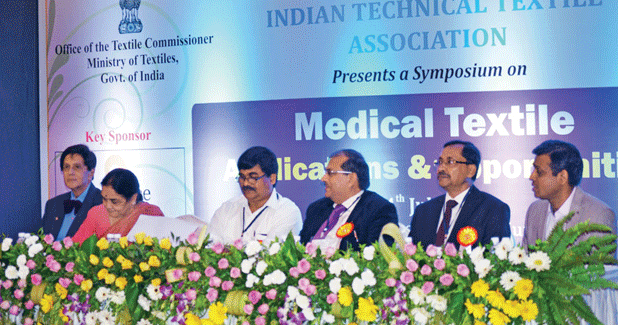
Medical textiles set to grow at 9% CAGR in India
Medical community and healthcare markets have much to gain by the growth of technical textiles industry, and India has only seen the tip of this vast potential for the domestic as well as global market, finds the Editor of The ITJ, reporting on an ITTA-organised seminar in Mumbai recently.
Medical community and healthcare markets have much to gain by the growth of technical textiles industry, and India has only seen the tip of this vast potential for the domestic as well as global market, finds the Editor of The ITJ, reporting on an ITTA-organised seminar in Mumbai recently.
Medical textile market in India is estimated at around $600 million in 2014, of which surgical dressings and surgical sutures alone account for about more than 50 per cent at $380. Universal health coverage scheme, 100 per cent FDI under automatic route and support to PPP model to improve availability of health care services are among the initiatives which will impact on the consumption.
In healthcare, India is the sixth largest market globally in terms of size with the figure at $80 billion USD in 2014. Telemedicine is a fast-emerging sector in India; many major hospitals (Apollo, AIIMS) have adopted telemedicine services and entered into a number of PPPs. Health insurance is gaining momentum in India; gross healthcare insurance premium is $2.9 billion in 2013 expanding at a CAGR of 26 per cent. Sundara Moorthy, Head – Healthcare Consulting Division, BDB India Private Limited, Pune disclosed this recently at a Seminar on ¨Medical Textile — Applications & Opportunities¨, organised by the Indian Technical Textile Association at the MCA Banquets, Mumbai Cricket Association (MCA), Bandra Kurla Complex in Mumbai.
He also revealed that the medical textile market is expected to grow from $600 million in 2014 to $780 million by 2017, at a CAGR of 8-9 per cent.
In His welcome address, Pramode Khosla, Chairman of ITTA underscored the importance of the growing medical textiles in India. BB Bharti, Joint Textile Commissioner enumerated the steps the Government has undertaken to promote technical textiles in the country. Dr Snehalata Deshmukh, Fomer Vice Chancellor, Mumbai University, talked of the importance of modern technologies and sophisticated products for the welfare of the citizens.
Kiran Soni Gupta, textile Commissioner, who joined a seminar at a later stage, spoke at length on the burgeoning population and the need for faster growth of technical textile industry to serve them. Dr Anup Rakshit, Executive Director of ITTA delivered a vote of thanks, saying that ITTA would be organising more such seminars for the benefit of the technical textile industry in the coming months.
The seminar proved very interesting to a select audience of about 170, which included doctors & professionals and from medical textile industry. Dr JT Vyas, General Surgeon, Nanavati Hospital; Dr Narendra Mehta, Senior Surgeon, Lilavati Hospital, Mumbai; and Dr Sharad Sheth, Mumbai were included among the session chairpersons. It was their comments, frank and forthright that set the tone and the moods of the seminar. One of them even went to the extent of confessing that even doctors are not 100 per cent proof in protection, as some of them even wear the same surgical gown that some other doctor wore a few hours ago. The health & hygiene consciousness in India has not reached the highest level of the West. But things are changing and, medical textiles, which is now in its infancy, is set to grow tremendously.
Sundara Moorthy cited the following as the major growth drivers of the Indian medical textiles segment: Growing needs for better and convenient primary wound dressing materials; Use of smart textiles in healthcare field; Increasing number of cardiac surgeries in India; Growing disposable income increasing accessibility towards medical textile products; Increasing consciousness among people with regard to personal care and hygiene; Aging population; Developments happening in the Textile scaffold; Increasing usage of contact lenses.




